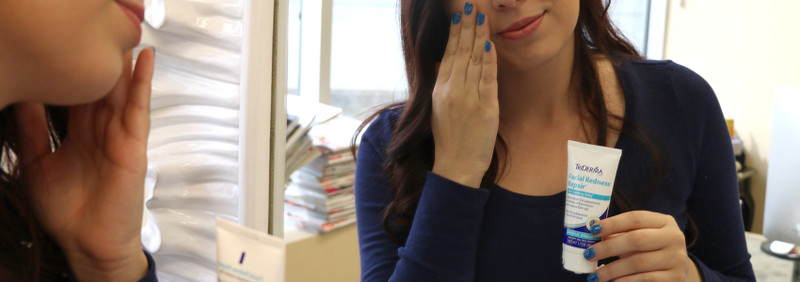Not all facial redness is just flushing or blushing. For many adults over the age of 30, redness on the cheeks, nose, chin or forehead that comes and goes frequently could be a reoccurring form of rosacea.
Constant and bothersome flareups are common in the facial skin disorder, which in some cases, can also appear on the chest, ears, neck and scalp. While rosacea can affect anyone, those with fair skin would normally be more sensitive to symptoms and be at the much greater risk. While there is no cure for the condition and the cause is unknown, those who seek out the proper medical attention quickly for their rosacea can find therapeutic solutions to keep symptoms at bay and even potentially reverse major signs.
There are four major subtypes of rosacea, categorized by their patterns and symptoms. Additional symptoms can include dry, plaque patched skin and facial swelling known as edema. Understanding where symptoms fall in the spectrum of rosacea helps to best determine how to control and quell each unique condition. There are four subtypes of rosacea:
- Subtype 1 This subtype is known as erythematotelangiectatic rosacea, is characterized by flushing that comes and goes regularly, as well as persistent redness that resembles a sunburn, and can include small visible blood vessels.
- Subtype 2 This subtype is known as papulopustular rosacea, is characterized by the same persistent redness that also includes small, red transient bumps and pusfilled pimples, similar to acne. These bumps can cause burning or stinging of the face, leaving a sufferer feeling itchy or tight.
- Subtype 3 This subtype is known as phymatous rosacea, is characterized by thickening and enlarging skin due to excess tissue. Those suffering from Subtype 3 may experience rhinophyma, where the nose grows swollen and bumpy.
- Subtype 4 This subtype is known as ocular rosacea, is characterized by watery, bloodshot and irritated eyes. The eyelids can become red and swollen and in severe cases, vision can be lost due to corneal damage.
Symptoms of rosacea can span more than just one subtype, and often progress from moderate to severe if not diagnosed and treated early on. Because each rosacea case can differ greatly between patients, treatment is designed to suit the severity of each individual’s signs. Oral and topical options are the most common for treatments prescribed for symptoms like bumps and redness.
Our Facial Redness Repair™ & Facial Redness Cleanser™ are a great way to reverse facial redness for acute to mild facial redness problems. Both provide soothing relief for red, irritated or sensitive skin and help to heal blemishes and improve the overall appearance of skin. The main ingredient, aloe barbadensis (AP4® Aloe Complex), acts alongside soothing botanicals, as an important healing component. For more intense symptoms like those related to blood vessels, extensive redness and disfigurement of the nose, laser and pulsed light sources are often recommended to lessen the visible effects rosacea causes.

